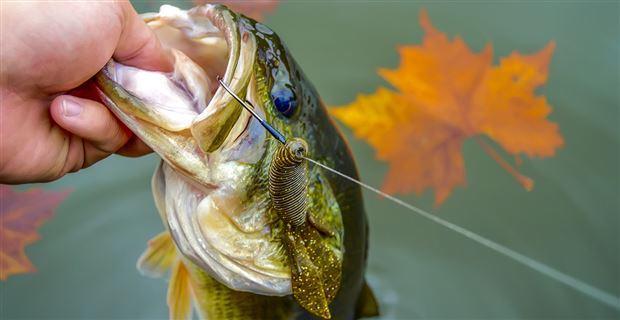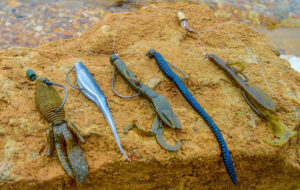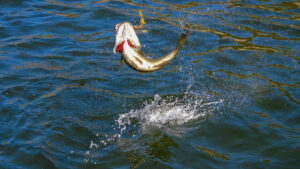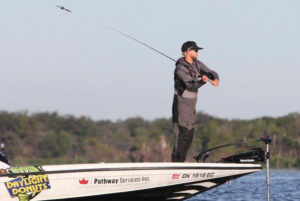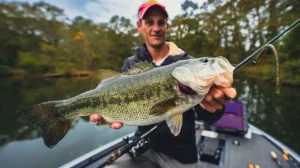Fall fishing has long since settled in around the country. The leaves are falling, the deer are hearing Nature’s call, baitfish are schooling up and bass are feeding for winter. Some of the best bass fishing of the entire year is upon us. We’ve all heard how productive hard baits like topwaters, crankbaits and spinnerbaits are in the fall, but what about soft plastics?
It seems as the leaves wither and drop from the trees, soft plastics follow a similar path and fall out of most anglers’ boats. This isn’t true for Bassmaster Elite Series pro James Elam. He makes sure to keep his soft plastics rigged and ready to go.
“You can always find some fish that’ll eat a soft plastic, especially in the fall,” Elam said.
Elam dives into detail about his 5 favorite soft plastic presentations for fall bass fishing and the methods to his madness when employing these lures below.
Texas-rigged beaver
Elam’s favorite soft plastic bait in the fall when it comes to flipping and pitching is a simple Texas-rigged beaver type bait.
“A Texas-rigged soft plastic is an extremely versatile bait throughout the entire year,” Elam said. “If you’re on a grass lake you can punch it, you can cast a big worm and drag it around, swim it, flip it, and the list goes on. When fall rolls around and I’m flipping cover, I’ll have a Beaver on one rod.
Instead of getting hung up on the intricacies of a Texas-rig, Elam simplifies the details as much as possible. He doesn’t stick to only one soft plastic, but instead will test the waters with beaver-style baits like a Reaction Innovations Sweet Beaver or a Missile Baits D-Bomb until he finds what the fish want.
“I’ll rig up a 3/8-ounce tungsten sinker, pegged to 25-pound fluorocarbon, with a 4/0 Owner Wide Gap hook and switch out different plastics until I find something they are eating,” Elam said. “Don’t make color selection too difficult. Stick with green pumpkin, plum or black and blue 95 percent of the time.”
Isolated cover becomes Elam’s focal point with this set-up. Whether it is a dock, a lone stump, laydown tree, or a boulder; he’ll flip his beaver in and around the targets. Elam gets away with a light flipping weight this time of the year, as the bass he targets with this presentation are often dirt shallow.
Elam notices a lot of anglers gravitate towards using a jig when flipping in the fall. For this very reason Elam does his best to show them something different.
“Its not that a jig won’t catch bass in the fall,” Elam said. “The bass just see a lot of jigs, and for whatever reason, a lot of people put down their soft plastics. Knowing this gives me more confidence to pick up a beaver and toss it around. The bass aren’t as conditioned to it this time of year.
Swinging “wobble heads”
A second presentation Elam has found effective during the autumn months is a swinging or wobble jighead rigged with some variation of soft plastic creature bait. Bass fishing legend Tommy Biffle has made this presentation famous over the years by throwing the Gene Larew Biffle Bug with a Biffle Hardhead.
“I’ll throw a myriad of different soft plastic creature baits on my swing-heads,” Elam said. “The Biffle Bug is a great place to start if you’re new to the set-up, but anything like a Zoom Brush Hog or YUM Christie Critter will work. You want to make sure the bait has some appendages that’ll give off action while you reel the bait back to the boat.”
Elam opts for throwing the heaviest weight swing head he can get away with, to assist maintaining bottom contact, which is imperative. In the fall, Elam sticks to 1/2-ounce Owner Pivot Head and throws it on 17-pound fluorocarbon. He can effectively fish this in any depth range, from 3 feet to 20 feet with ease.
“I like to target structure like wind blown transition banks, points, or shallow rocks with a swing head,” Elam explained. “You essentially work this lure like a crankbait. Cast it out there, make sure it sinks to the bottom, and slowly wind it back. The appendages on your soft plastic of choice will flutter around, creating a lot of action, and the bass can’t resist it.”
Lightweight Carolina rig
Another offering Elam utilizes in the fall in 4-12 foot depths is a “lightweight” Carolina Rig. He prefers to throw a 1/2-ounce weight throughout the autumn months and fishes it shallower than usual.
“The Carolina rig is another presentation guys seemingly forget about this time of year, “ Elam said. “It’s a great bait to show bass that have been getting a lot of pressure, because the chances are they haven’t seen one in a while. I’ll target the corners of docks, points, shallow humps, and lead in banks inside creeks with this set-up.”
Soft jerkbait
When Elam finds himself amidst schooling bass in the fall he’ll reach for a Zoom Super Fluke or Super Fluke Jr. Especially when bass are busting shad on the surface but won’t react to a topwater. A fluke in some variation of white or silver is a perfect shad imitation. Elam varies the size of fluke he uses depending on how large the forage is the bass are feeding on.
“I use a weightless Texas-rig presentation when fishing a fluke,” Elam said. “More often than not, I am throwing it on 8-pound fluorocarbon line and spinning gear. With light line and a spinning setup I can make extremely long, accurate casts; and even skip the weightless lure under docks or overhanging limbs. When bass are gorging on shad, they will absolutely smoke a fluke.
“I fish a fluke almost like a topwater, twitching it fast across the surface. But you can work this bait throughout the entire water column, and around almost every type of cover. It’s possible I’ll be burning a fluke in the back of a pocket for schoolers in the morning and then slowly twitching it in the shade lines of docks in the afternoon. It flat out catches bass anywhere.”
Shaky head
Much like a fluke, Elam emphasizes he doesn’t go to any lake in the fall without a shaky head tied on. A shaky head is another bait that will catch bass throughout the entire country.
“I go with a 3/16 ounce Owner Shaky Ultrahead on 8 pound fluorocarbon and a spinning set-up,” Elam explained. “Thread on your favorite 5 to 7 inch straight tail worm and you’re ready to fish. Green pumpkin is hard to beat as far as color selection goes, although I do like throwing a plum color if there is some cloud cover, especially around the Oklahoma lakes I grew up fishing.”
The main reason a shaky head is a staple lure for Elam is he can productively fish this lure at any depth. He stresses maintaining bottom contact and slowly dragging a shaky head across the bottom, employing the telltale “shaking” action only when milking a specific spot or area.
“You can fish a shaky head anywhere,” Elam admitted. “A 3/16-ounce head is perfect from the bank (inches of water) out to about 20 feet. After that, you’ll want to use a slightly heavier head. I use it as a follow-up bait to my swing head or on any offshore sweet spots I am fishing. Keep it moving, slow and steady, and you will get some bites.”
Other fall fishing tools
Elam made a point to discuss the practicality of his Power Poles throughout the fall months. We often hear anglers talk about their Power Poles when fishing a grass dominant fishery, or when targeting bedding bass. But Elam warns to not forget about these tools in the fall.
“My Power Poles play a huge role in my fall fishing,” Elam said. “Bass tend to gang up big time in the fall. They’ll get on little sweet spots on a flat, or school up in wolf packs when feeding on shad in the back of a creek. This is when I’ll drop my poles and make repeated casts. Allowing me to effectively work a slow, bottom presentation or milk a spot for all it’s worth.”
While others store their boats and swap their fishing tackle for camouflage, those that get on the water in the coming weeks will enjoy some unbelievably productive fishing trips.


